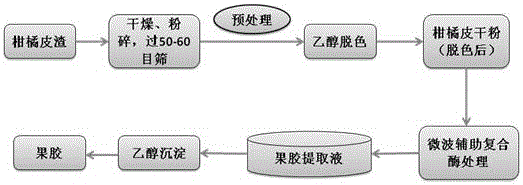Method for extracting pectin from citrus peel pomace
A technology of citrus peel and pectin, which is applied in the fields of deep processing of agricultural products and recycling of solid waste, can solve the problems of weak competitiveness in overseas markets, irrational use of resources, and small scale of enterprises, and solve the shortage of pectin resources, Realize the effect of resource utilization and short action time
- Summary
- Abstract
- Description
- Claims
- Application Information
AI Technical Summary
Problems solved by technology
Method used
Image
Examples
Embodiment 1
[0029] Adopt the following method to extract pectin from citrus peel, the specific steps are as follows:
[0030] 1) Pretreatment: Take fresh citrus peels, dry them (dry at 70°C, and turn them from time to time, and dry them to a moisture content of about 9%), crush them, and pass them through a 50-mesh sieve for later use. Accurately weigh a certain amount of sample, wrap it with filter paper, and treat it for 5.5 h with absolute ethanol twice soaking method and Soxhlet extraction method respectively, then rinse with hot water at 58°C until the solution is colorless, and drain for later use.
[0031] 2) Decolorization: 95% ethanol was used as the extraction agent, and the volume ratio of solid to liquid was 1:4. The sieved citrus peel dry powder was decolorized for 4.5 h at a temperature of 54 °C.
[0032] 3) Extraction: add a certain amount of citric acid buffer solution to the decolorized raw material, adjust the volume ratio of material to liquid to 1:13, and pH to 4.2, th...
Embodiment 2
[0035] Adopt the following method to extract pectin from citrus peel, the specific steps are as follows:
[0036] 1) Pretreatment: Take fresh citrus peels, dry them (dry at 65°C, and turn them from time to time until the moisture content is about 10%), crush them, and pass them through a 60-mesh sieve for later use. Accurately weigh a certain amount of sample, wrap it with filter paper, and treat it for 6.5 hours by double immersion in absolute ethanol and Soxhlet extraction respectively, then rinse with hot water at 60°C until the solution is colorless, and drain for later use.
[0037] 2) Decolorization: 95% ethanol was used as the extraction agent, and the volume ratio of solid to liquid was 1:4.5. The sieved citrus peel dry powder was decolorized at 52 °C for 5 h.
[0038] 3) Extraction: add a certain amount of citric acid buffer solution to the decolorized raw material, adjust the volume ratio of material to liquid to 1:14, and pH to 4.0, then add 0.7% compound enzyme (ce...
Embodiment 3
[0041] Adopt the following method to extract pectin from citrus peel, the specific steps are as follows:
[0042] 1) Pretreatment: Take fresh citrus peels, dry them (dry at 75°C, and turn them from time to time, and dry them to a moisture content of about 8%), crush them, and pass them through a 60-mesh sieve for later use. Accurately weigh a certain amount of sample, wrap it with filter paper, and treat it with absolute ethanol twice soaking method and Soxhlet extraction method respectively for 6 h, then rinse with hot water at 60°C until the solution is colorless, and drain it for later use.
[0043] 2) Decolorization: 95% ethanol was used as the extraction agent, and the volume ratio of solid to liquid was 1:4.3. The sieved citrus peel dry powder was decolorized at 53°C for 5.5 h.
[0044] 3) Extraction: add a certain amount of citric acid buffer solution to the decolorized raw material, adjust the volume ratio of material to liquid to 1:15, and pH to 4.5, then add 0.65% co...
PUM
 Login to View More
Login to View More Abstract
Description
Claims
Application Information
 Login to View More
Login to View More - R&D
- Intellectual Property
- Life Sciences
- Materials
- Tech Scout
- Unparalleled Data Quality
- Higher Quality Content
- 60% Fewer Hallucinations
Browse by: Latest US Patents, China's latest patents, Technical Efficacy Thesaurus, Application Domain, Technology Topic, Popular Technical Reports.
© 2025 PatSnap. All rights reserved.Legal|Privacy policy|Modern Slavery Act Transparency Statement|Sitemap|About US| Contact US: help@patsnap.com

